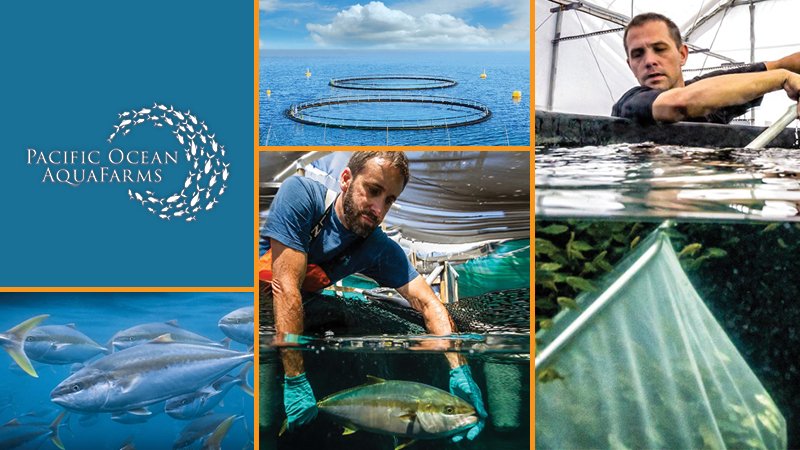Proposed Offshore California Fish Farm to Create 300+ Jobs
Pacific Ocean AquaFarms (POA – www.poaquafarms.com), based in California, is developing an aquaculture facility in the open ocean off the shores of southern California. The fish farm facility, which will utilize the latest science and technology, would be located in federal waters to sustainably grow California yellowtail (Seriola dorsalis), a native species.
Stronger America Through Seafood (SATS) interviewed Don Kent, CEO of Pacific Ocean AquaFarms and The Hubbs-SeaWorld Research Institute, to learn more about this pioneering project in California, as well as the benefits to the state, which includes the creation of estimated 300+ jobs and over $50 million in sales annually. Don also discusses the immediate need for passage of federal legislation to help support growth of the offshore aquaculture industry in America.
Can you tell us about Pacific Ocean AquaFarms (POA)?
POA will pioneer sustainable, domestic aquaculture in the U.S. EEZ (exclusive economic zone) which is the largest contiguous EEZ in the world. POA is funded by Pacific6, a purpose-driven investment fund committed to expanding safe, sustainable and scalable aquaculture in the U.S. The Hubbs-SeaWorld Research Institute has been and will continue to provide consulting services on science and technology, best aquaculture practices and long-term sustainability. POA will cultivate California yellowtail, a highly desirable species, close to Southern California’s vast seafood markets.
How is POA a pioneer in the U.S.?
Marine farming is common around the world and practiced primarily in nearshore environments. By siting a farm in the open-ocean off southern California, POA will demonstrate how to use comprehensive spatial analysis, innovative engineering, and the beneficial characteristics of a carefully selected offshore location to create a new environmentally and economically sustainable way to produce our seafood. The U.S. imports the vast majority of its seafood (and half of the seafood produced in other countries is farmed). POA will be a model for how offshore aquaculture can help us sustainably grow more of the seafood we consume in the U.S. POA will be permitted under an existing and extensive regulatory framework that has never been applied to offshore aquaculture in practice. Unique to the permitting process is that through an interagency agreement, NOAA Fisheries is the lead agency coordinating the National Environmental Protection Act (NEPA) review in a first for that agency and for domestic, open-ocean aquaculture. POA is paving the way to 'Do it Here, Do it Right, Do it Now.' - by emphasizing proven science, embracing regulatory oversight, utilizing best practices and latest technologies, and demonstrating a diligent concern for the environment.
What role can aquaculture play in feeding the world sustainably?
Global population recently reached 8 billion and is projected to reach 10 billion by the middle of the century, dramatically increasing demand for food, especially protein. A growing middle class around the world is also increasing demand for protein, especially healthful animal protein, especially seafood. Aquaculture is simply the most environmentally sound method for producing animal protein for human consumption as it requires far less land, fresh water and energy than land-based animal protein production, and generates far less GHGs. The answer to the question, “How do we produce more food more sustainably?” is obvious, but the U.S. lags behind other nations in its domestic production of seafood.
How does the expansion of aquaculture in the U.S. benefit communities?
More than just reducing our reliance on other countries and providing food security for our nation, an expanded aquaculture industry will create new jobs and provide significant economic impact. An earlier study for POA estimated the project will ultimately sustain more than 300 permanent jobs, generate more than $50 million in annual sales and more than $100 million in new regional spending. Marine farming will create a new, locally produced source of seafood, which has significant health benefits, in many coastal communities. Expanding aquaculture will preserve and invigorate working waterfronts, while using existing seafood processing and distribution infrastructure, and creating new synergies with the wild-fishing industry thereby fostering a new, sustainable food-production industry that will generate community pride.
How would passage of federal legislation help support the expansion of domestic aquaculture and make the U.S. industry more competitive globally?
Federal legislation will clarify and codify the permitting process, which now spans numerous regulatory authorities and sometimes repetitive requirements. New legislation would reinforce existing regulatory requirements thereby confirming U.S. sustainability and food safety standards, which are some of the highest standards in the world. It would also provide greater certainty for investors who are reluctant to pursue projects that may never come to fruition. All of these factors would combine to reduce our nation’s shocking seafood trade deficit, currently estimated to be about $17 billion, second only to oil.
It is our hope and our intent that 2023 is the year that POA and domestic aquaculture make real, meaningful progress for the U.S. and will help to demonstrate a new standard for sustainable marine farming.

